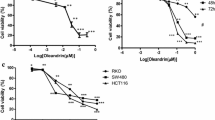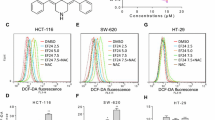Abstract
Sulindac sulfone (also known as exisulind) and its chemical derivatives are promising anticancer agents capable of inducing apoptosis in a variety of malignant cell types with minimal toxicity to normal cells. Here, we tested the ability of alpha-tocopheryl succinate (TOS), another promising anticancer agent, to sensitize colon cancer cells to exisulind-induced apoptosis. We found that sub-apoptotic doses of TOS greatly enhanced exisulind-induced growth suppression and apoptosis in the HCT116, LoVo and SNU-C4 human colon cancer cell lines. Our results revealed that this was accounted for primarily by an augmented cleavage of poly(ADP-ribose) polymerase (PARP) and enhanced activation of caspase-8, -9 and -3. Pretreatment with z-VAD-FMK (a pan-caspase inhibitor), z-IETD-FMK (a caspase-8 inhibitor) or z-LEHD-FMK (a caspase-9 inhibitor) blocked TOS and exisulind cotreatment-induced PARP cleavage and apoptosis. Furthermore, TOS/exisulind cotreatment induced JNK phosphorylation, while pretreatment with SP600151 (a JNK inhibitor) partially blocked cotreatment-induced caspase-dependent PARP cleavage and apoptosis. Taken together, these findings indicate that TOS sensitizes human colon cancer cells to exisulind-induced apoptosis. Apoptotic synergy induced by exisulind plus TOS seems likely to be mediated through a mechanism involving activation of caspases and JNK.
Similar content being viewed by others
References
Goluboff ET (2001) Exisulind, a selective apoptotic antineoplastic drug. Expert Opin Investig Drugs 10:1875–1882
Stoner GD, Budd GT, Ganapathi R, et al (1999) Sulindac sulfone induced regression of rectal polyps in patients with familial adenomatous polyposis. Adv Exp Med Biol 470:45–53
Goluboff ET, Shabsigh A, Saidi JA, et al (1999) Exisulind (sulindac sulfone) suppresses growth of human prostate cancer in a nude mouse xenograft model by increasing apoptosis. Urology 53:440–445
Whitehead CM, Earle KA, Fetter J, et al (2003) Exisulind-induced apoptosis in a non-small cell lung cancer orthotopic lung tumor model augments docetaxel treatment and contributes to increased survival. Mol Cancer Ther 2:479–488
Yoon JT, Palazzo AF, Xiao D, et al (2002) CP248, a derivative of exisulind, causes growth inhibition, mitotic arrest, and abnormalities in microtubule polymerization in glioma cells. Mol Cancer Ther 1:393–404
Xiao D, Deguchi A, Gundersen GG, Oehlen B, Arnold L, Weinstein IB (2006) The sulindac derivatives OSI-461, OSIP486823, and OSIP487703 arrest colon cancer cells in mitosis by causing microtubule depolymerization. Mol Cancer Ther 5:60–67
Soh JW, Mao Y, Kim MG, et al (2000) Cyclic GMP mediates apoptosis induced by sulindac derivatives via activation of c-Jun NH2-terminal kinase 1. Clin Cancer Res 6:4136–4141
Rice PL, Goldberg RJ, Ray EC, Driggers LJ, Ahnen DJ (2001) Inhibition of extracellular signal-regulated kinase 1/2 phosphorylation and induction of apoptosis by sulindac metabolites. Cancer Res 61:1541–1547
Li H, Liu L, David ML, et al (2002) Pro-apoptotic actions of exisulind and CP461 in SW480 colon tumor cells involve beta-catenin and cyclin D1 down-regulation. Biochem Pharmacol 64:1325–1336
Soh JW, Mao Y, Liu L, Thompson WJ, Pamukcu R, Weinstein IB (2001) Protein kinase G activates the JNK1 pathway via phosphorylation of MEKK1. J Biol Chem 276:16406–16410
Thompson WJ, Piazza GA, Li H, et al (2000) Exisulind induction of apoptosis involves guanosine 3’,5’-cyclic monophosphate phosphodiesterase inhibition, protein kinase G activation, and attenuated beta-catenin. Cancer Res 60:3338–3342
Czibere A, Prall WC, Zerbini LF, et al (2005) The nonsteroidal anti-inflammatory drug Exisulind selectively induces apoptosis via JNK in secondary acute myeloid leukemia after myelodysplastic syndrome. Cell Cycle 4:812–817
Weber T, Lu M, Andera L, et al (2002) Vitamin E succinate is a potent novel antineoplastic agent with high selectivity and cooperativity with tumor necrosis factor-related apoptosis-inducing ligand (Apo2 ligand) in vivo. Clin Cancer Res 8:863–869
Kang YH, Lee E, Choi MK, et al (2004) Role of reactive oxygen species in the induction of apoptosis by alpha-tocopheryl succinate. Int J Cancer 112:385–392
Zu K, Hawthorn L, Ip C (2005) Up-regulation of c-Jun-NH2-kinase pathway contributes to the induction of mitochondria-mediated apoptosis by alpha-tocopheryl succinate in human prostate cancer cells. Mol Cancer Ther 4:43–50
Zhao B, Yu W, Qian M, et al (1997) Involvement of activator protein-1 (AP-1) in induction of apoptosis by vitamin E succinate in human breast cancer cells. Mol Carcinog 19:180–190
Lim SJ, Simeone AM, Kim CK, Tari AM (2002) Cyclosporin A enhances the apoptotic effects of N-(4-hydroxyphenyl)retinamide in breast cancer cells. Int J Cancer 101:243–247
Lim SJ, Lopez-Berestein G, Hung MC, Lupu R, Tari AM (2000) Grb2 downregulation leads to Akt inactivation in heregulin-stimulated and ErbB2-overexpressing breast cancer cells. Oncogene 19:6271–6276
Rice PL, Kelloff J, Sullivan H, et al (2003) Sulindac metabolites induce caspase- and proteasome-dependent degradation of beta-catenin protein in human colon cancer cells. Mol Cancer Ther 2:885–892
Minami T, Adachi M, Kawamura R, Zhang Y, Shinomura Y, Imai K (2005) Sulindac enhances the proteasome inhibitor bortezomib-mediated oxidative stress and anticancer activity. Clin Cancer Res 11:5248–5256
Ohishi T, Kishimoto Y, Miura N, et al (2002) Synergistic effects of (−)-epigallocatechin gallate with sulindac against colon carcinogenesis of rats treated with azoxymethane. Cancer Lett 177:49–56
Chan DC, Earle KA, Zhao TL, et al (2002) Exisulind in combination with docetaxel inhibits growth and metastasis of human lung cancer and prolongs survival in athymic nude rats with orthotopic lung tumors. Clin Cancer Res 8:904–912
Soriano AF, Helfrich B, Chan DC, Heasley LE, Bunn PA Jr, Chou TC (1999) Synergistic effects of new chemopreventive agents and conventional cytotoxic agents against human lung cancer cell lines. Cancer Res 59:6178–6184
Lei K, Davis RJ (2003) JNK phosphorylation of Bim-related members of the Bcl2 family induces Bax-dependent apoptosis. Proc Natl Acad Sci U S A 100:2432–2437
Ma WY, Huang C, Dong Z (1998) Inhibition of ultraviolet C irradiation-induced AP-1 activity by aspirin is through inhibition of JNKs but not erks or P38 MAP kinase. Int J Oncol 12:565–568
Yamamoto K, Ichijo H, Korsmeyer SJ (1999) BCL-2 is phosphorylated and inactivated by an ASK1/Jun N-terminal protein kinase pathway normally activated at G(2)/M. Mol Cell Biol 19:8469–8478
Martindale JL, Holbrook NJ (2002) Cellular response to oxidative stress: signaling for suicide and survival. J Cell Physiol 192:1–15
Shen HM, Liu ZG (2006) JNK signaling pathway is a key modulator in cell death mediated by reactive oxygen and nitrogen species. Free Radic Biol Med 40:928–939
Rice PL, Peters SL, Beard KS, Ahnen DJ (2006) Sulindac independently modulates extracellular signal-regulated kinase 1/2 and cyclic GMP-dependent protein kinase signaling pathways. Mol Cancer Ther 5:746–754
Witta SE, Gustafson DL, Pierson AS, et al (2004) A phase I and pharmacokinetic study of exisulind and docetaxel in patients with advanced solid tumors. Clin Cancer Res 10:7229–7237
Jones SF, Kuhn JG, Greco FA, et al (2005) A phase I/II study of exisulind in combination with docetaxel/carboplatin in patients with metastatic non-small-cell lung cancer. Clin Lung Cancer 6:361–366
Author information
Authors and Affiliations
Corresponding author
Additional information
S.-J. Lim, Y.-J. Lee both authors are contributed equally to this study.
Rights and permissions
About this article
Cite this article
Lim, SJ., Lee, YJ., Park, DH. et al. Alpha-tocopheryl succinate sensitizes human colon cancer cells to exisulind-induced apoptosis. Apoptosis 12, 423–431 (2007). https://doi.org/10.1007/s10495-006-0620-9
Published:
Issue Date:
DOI: https://doi.org/10.1007/s10495-006-0620-9




